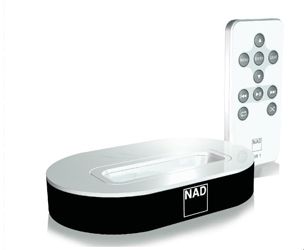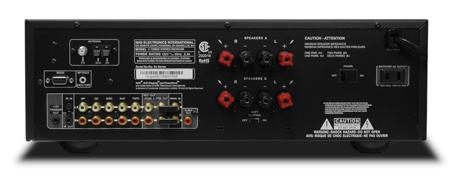NAD C 725BEE Stereo Receiver Page 2

SETUP
As implied earlier, setting up the C 725BEE was an exercise in simplicity. I just plugged the CD player and iPod dock sources into the analog RCA inputs, hooked up my main left and right speakers, and powered up. I also hooked up an antenna for the RDS-capable FM tuner, which performed as expected, pulling in all the stations I usually get with my table-top antenna and delivering stable, quiet operation on the strongest signals.
Actually, the most time-consuming thing I had to do in setting up the C 725BEE was run the long RCA cable from the receiver's subwoofer output to my powered sub and play with its controls on some test tracks to affect the right balance. Fifteen minutes later, I was done.
PERFORMANCE
I played a wide variety of music through the C 725BEE on my main reference speakers. These are mid-size British-made towers of about average sensitivity (89 dB), though the nominal 6-ohm load they present to the amplifier makes them a bit more demanding than the typical 8-ohm speaker pair. The towers were mated with my 12-inch powered sub. My listening studio is a basement room 18 feet deep by 14 feet wide, fully carpeted, and topped with a full-height acoustic tile dropped ceiling.

Under normal listening conditions, that is, with room filling but not overwhelming volume, I found the C 725BEE to be a capable receiver whose performance compared well with my considerably more expensive audio separates. That is to say it was smooth, detailed, and surprisingly dynamic for such a small amplifier.
I started my listening with a female vocal from Carmen Lundy's Self Portrait album, released on the JVC XRCD label. The slowly struck piano notes that open the ballad "Spring Can Really Hang You Up The Most" were centered in the soundstage, right where I expected them. I could clearly follow the soft initial attack and long decay of each note and delineate its tone; my ability to place the higher pitched notes slightly right of the lower notes suggested close miking of the instrument and good spatial rendering by the receiver. The accompanying strings sounded nicely textured and smooth with no harshness and I heard good detail in the brushed cymbal. The bass line was delivered with good definition, while Lundy's voice in this melancholy ode to spoiled romance came across solid, stable, and full- bodied.
I had similar happy results with the country-pop crossover band Rascal Flatts on "Stand," a rocking track from Me and My Gang (Lyric Street Records). The song starts with guitar strums, then the big bass comes in, followed by vocals and a tambourine. The NAD rose to the dynamic demands of this track and delivered superb details in the strike of the tambourine's skin and the metallic rustle of its rattles.
To test the C725BEE's dynamic capabilities and tonal balance, I played an orchestral recording, the "Marche au Supplice" (March to the Scaffold) on Telarc's CD of the Cincinnati Symphony Orchestra playing the Berlioz Symphonie Fantastique. This movement builds in pace, complexity, and volume as it progresses, and it jumps from quiet to loud - sometimes to really loud - several times throughout the track. The C725BEE kept the different instrumental lines discernable even when cranked to a fairly high volume. And when the rest of the orchestra dropped back to let the flutes have a quick say - only to be answered quickly and loudly by the massed horns - I nearly jumped from my seat.
Throughout my tests, I mostly found the C 725BEE to be a juicy treat for serious music listening. My one notable caveat is that I did find myself wishing the receiver had more power. Though NAD would argue, fairly, that this receiver delivers (in the audiophile slang) "really big watts," there is only so much volume that you can reasonably expect a 50-WPC amplifier to push before it hits the wall. Certainly, torture-test tracks like "March to the Scaffold" convinced me that the PowerDrive feature works; this modest receiver, when cranked to deliver around 90 to 95 dB SPL output on my meter, cleanly hit peaks that pinned the needle and would have caused it to settle somewhere above 106 db. But the amp was clearly most comfortable and sounded its smoothest at more moderate volumes. And while the receiver's Soft-Clipping circuit (activated with a slide switch on the back panel) did take off a bit of the edge when I intentionally pushed the amp beyond its means, I chose to leave it off because it is acknowledged to reduce power, though NAD says the difference is minuscule and would be imperceptible.
BOTTOM LINE
The C 725BEE is a highly competent stereo receiver that faithfully passed along the magic in my best audiophile recordings. True, its power rating probably makes it best-suited for small- to mid-size rooms and for music best enjoyed at moderate volume - if you're a hard-rock headbanger who likes to really crank things up, this probably isn't your solution. But when the C 725BEE is used in the in the way that NAD intended, you'll find that it provides an awful lot of performance in a small package.













































